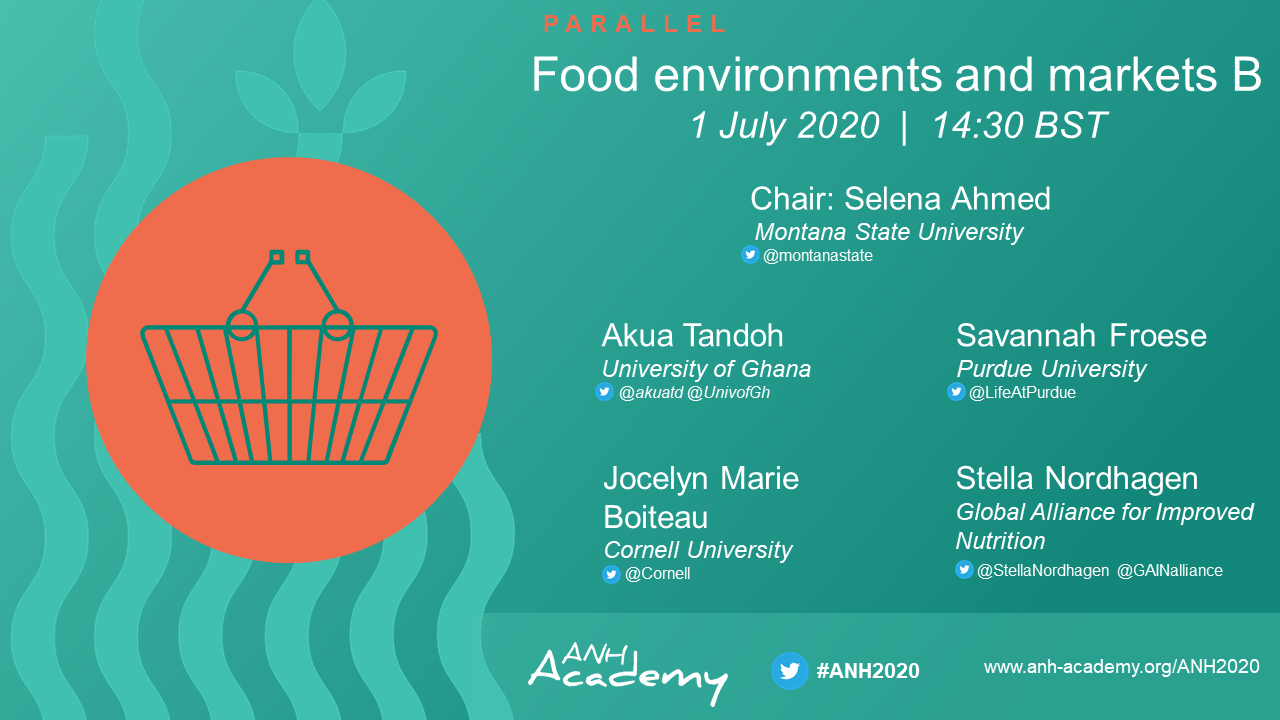
Intro animation:
Session recording:
Speakers and presentations:
- Session chair: Selena Ahmed, Montana State University
@montanastate - Akua Tandoh, University of Ghana
@akuatd @UnivofGh
Unhealthy food and beverage practices in everyday life in Ghanaian cities
Presentation | Slides - Jocelyn Marie Boiteau, Cornell University
@Cornell
Perspectives on quantity and quality food loss of perishable vegetables: food loss estimates across tomato supply chain actors in south India
Presentation | Slides - Savannah Froese, Purdue University
@LifeAtPurdue
Market food diversity and access drive household food purchase patterns and diets in Rural Tanzania: The EFFECTS study
Presentation | Slides - Stella Nordhagen, Global Alliance for Improved Nutrition
@StellaNordhagen @GAINalliance
Artisanal mining in rural Africa: Blurring the line between urban, non-agricultural and rural, agricultural food environments
Presentation | Slides
Abstracts:
Unhealthy food and beverage practices in everyday life in Ghanaian cities
Michelle Holdsworth1,2 Rebecca Pradeilles2 Francis Zotor3 Mark Green4 Akua Tandoh5 Senam Klomegah3 Hibbah Osei-Kwasi2 Nicolas Bricas6 Paula Griffiths7 Amos Laar5
1NUTRIPASS, French National Research Institute for Sustainable Development- IRD, 2University of Sheffield 3University of Health and Allied Sciences 4University of Liverpool, 5University of Ghana 6French Agricultural Research Centre for International Development (CIRAD) 7Loughborough University
Introduction
Urbanisation in Ghana is occurring at a rapid pace. This paradigm raises the concern of changing food environments and the accompanying transitioning of people’s dietary practices. Presently, there is little evidence on the driving role of urban environments on dietary practices in African cities. This requires an exploration of how habits related to food consumption are structured and organised in social practices, such as when unhealthy food and beverages are eaten, how quickly, where and with whom. Hence, this study investigated how unhealthy food and/or beverages are embedded in everyday life in Ghanaian cities.
Methods
Our study was sited in two Ghanaian cities- Accra (capital city) and Ho (provincial capital). We targeted deprived neighbourhoods in these cities and recruited participants with a quota sampling method (including occupation and economic status). We recruited 301 female and male adolescents/adults. All recruited participants were at least 13 years old and above. Qualitative in-depth 24-hour recalls were conducted via face-to-face interviews with all study participants. We collected data on all food and drink consumed inside/outside the home in the previous 24-hour period. The time of day of the food event (‘periodicity’); how long a food event lasts (‘tempo’); who participants eat with and where (‘synchronization’) were recorded. Scores were calculated to indicate the healthiness of foods based on energy and nutrient density. To answer the question of how unhealthy food and beverages are embedded in everyday life, we analysed how ‘tempo’, ‘periodicity’ and ‘synchronization’ are associated with the healthiness of foods consumed.
Findings
The dominant meal pattern was structured around 3 main meals a day with few snacks in between. Most study participants consumed unhealthy foods. However consumption of traditional foods that are nutrient rich but energy-dense persisted, with 89.4% of the sample consuming these. Low socio-economic groups were more likely to consume unhealthy foods and individuals who ate more frequently were less likely to eat unhealthy foods. The duration of most food episodes was quick (40.1% at <10 mins; 47.0% at 10-29 mins; 12.9% ≥30 minutes). Shorter food episodes were more likely to include greater intake of unhealthy foods, sweet foods or sugar sweetened beverages, in contrast with longer food episodes, which contained more traditional foods that were nutrient rich but also energy dense and often fried. Families and the home environment were very important in meal synchronization. 82% of meals were consumed at home- especially the evening meal which tended to be energy dense. Consumption of fried foods and sugar sweetened beverages were higher with friends, with whom breakfast was also often eaten. Eating alone was quite common (39% of the sample population).
Conclusion
The home environment and families are key to maintaining healthy diets. Eating with friends was associated with unhealthy eating practices. Low socio-economic groups were more likely to consume unhealthy foods. This association may be explained by the effects that poverty has on limiting frequency of food consumption to more filling energy dense foods. The association between poverty and consumption of unhealthy foods may also be mediated by the low cost of some unhealthy foods. Therefore, fiscal policies that subsidise healthy foods and tax unhealthy foods may promote public health goals.
References
Perspectives on quantity and quality food loss of perishable vegetables: food loss estimates across tomato supply chain actors in south India
Jocelyn Marie Boiteau1 Prabhu Pingali1
1Cornell University
Introduction
Globally, two billion people are food insecure, living without regular access to safe, nutritious and sufficient food (1). Food supply is a function of food production, imports, exports and losses. There is insufficient availability of fruits and vegetables in the global food system to meet the dietary needs of all people (2–4). Food loss (FL) in lower-income regions primarily occurs between production to retail stages (5). Fruits and vegetables are among the more perishable food groups and are more at risk of FL. Understanding the nature, stages and extent of FL is critical to designing FL prevention interventions.
Methods
We conducted an observational study in Chittoor and Hyderabad districts to estimate quantity and quality FL of fresh tomatoes from farm to retail. Tomatoes were selected because they are highly perishable (6), and are an important vegetable, globally (7). India is the world’s second largest tomato producer (8). In Andhra Pradesh and Telangana, tomato wholesale markets and urban vegetable markets are the major channels through which tomatoes are traded. Chittoor district, Andhra Pradesh is a major tomato producing region and Madanapalle tomato wholesale market is one of the largest tomato markets in Asia. Hyderabad, Telangana is a major metropolis where vegetable markets import tomatoes from surrounding wholesale markets, including Madanapalle. Survey data collection in Chittoor began in February 2019, and in Hyderabad in April 2019. We attempt to measure FL across the supply chain using same-day recalls from farmers, from harvest to markets, and wholesale traders who win auctions from participant farmers. We surveyed urban vegetable traders and retailers to measure FL at the urban market level. In this paper we attempt to answer the question: What is the extent of quantity and quality FL and at what stage does loss occur along tomato supply chains from farm to retail?
Findings
Farmers report the greatest quantity loss at post-harvest before tomatoes leave the farmgate, on average losing 8.7% (s.d. 11.9%) of total harvest (n=109 harvests). Farmers at the Madanapalle wholesale market report losing an average 1.5% (s.d. 4.8%) of total harvest at the market before auction (n=185 harvests). Farmers report the greatest quality loss at time of harvest, on average 24.4% (s.d. 54.0%) of total harvest damaged (n=161 harvests), compared with 0.9% (s.d. 3.5%) of total harvest damaged during post-harvest activities (n=109 harvests). Farmers most often report color, size and pest damage as important quality attributes. Tomato traders report an average quantity loss of 23.8% (s.d. 39.7%, n=21 auctions), and an average quality loss of 1.18% (s.d. 7.1%, n=16 auctions) of purchased tomatoes prior to transporting from the market. Tomato traders most often report firmness, shine, size, and color as important quality attributes. More stringent grading standards at the wholesale market level compared to the farm level may explain the higher levels of quantity loss at the market level. In Hyderabad, all vegetable traders report 0% (s.d. 0%) loss during trading activities (n=126 visits). Retailers report losing 2.6% (s.d. 18.1%) of tomatoes they had available to sell that day (n=249 visits).
Conclusion
Preliminary analysis of an ongoing survey across a tomato supply chain from farm to retail shows that all supply chain actors, with the exception of vegetable traders, report quantity FL. This loss was highest at the wholesale market. Farmers reported greater quality FL than tomato traders. Using same-day recalls, this study adds new insights into the stages and extent of FL along tomato supply chains in south India. Quantity and quality FL estimates within and between supply chain actors are essential to streamlining vegetable supply chains. Determining appropriate measurement methodologies will inform FL reduction interventions designed to improve food security.
References
FAO, IFAD, UNICEF, WFP, WHO. The State of Food Security and Nutrition in the World 2019. Safeguarding against economic slowdowns and downturns. Rome, FAO; 2019.
Siegel KR, Ali MK, Srinivasiah A, Nugent RA, Narayan KMV. Do we produce enough fruits and vegetables to meet global health need? PLoS One. 2014;9:1–7.Bah
adur KC K, Dias GM, Veeramani A, Swanton CJ, Fraser D, Steinke D, Lee E, Wittman H, Farber JM, Dunfield K, et al. When too much isn’t enough: Does current food production meet global nutritional needs? PLoS One. 2018;13:1–16.Ma
son-D’Croz D, Bogard JR, Sulser TB, Cenacchi N, Dunston S, Herrero M, Wiebe K. Gaps between fruit and vegetable production, demand, and recommended consumption at global and national levels: an integrated modelling study. Lancet Planet Heal. 2019;3:e318–29.
FAO. Global food losses and food waste - Extent, causes and prevention. Rome; 2011.
Kader AA. Postharvest biology and technology: an overview. Postharvest Technol Hortic Crop. 1992;15–20.
Schreinemachers P, Simmons EB, Wopereis MCS. Tapping the economic and nutritional power of vegetables. Glob Food Sec. Elsevier B.V.; 2018;16:36–45.
FAOSTAT. Production of Tomatoes: top 10 producers. 2016.







